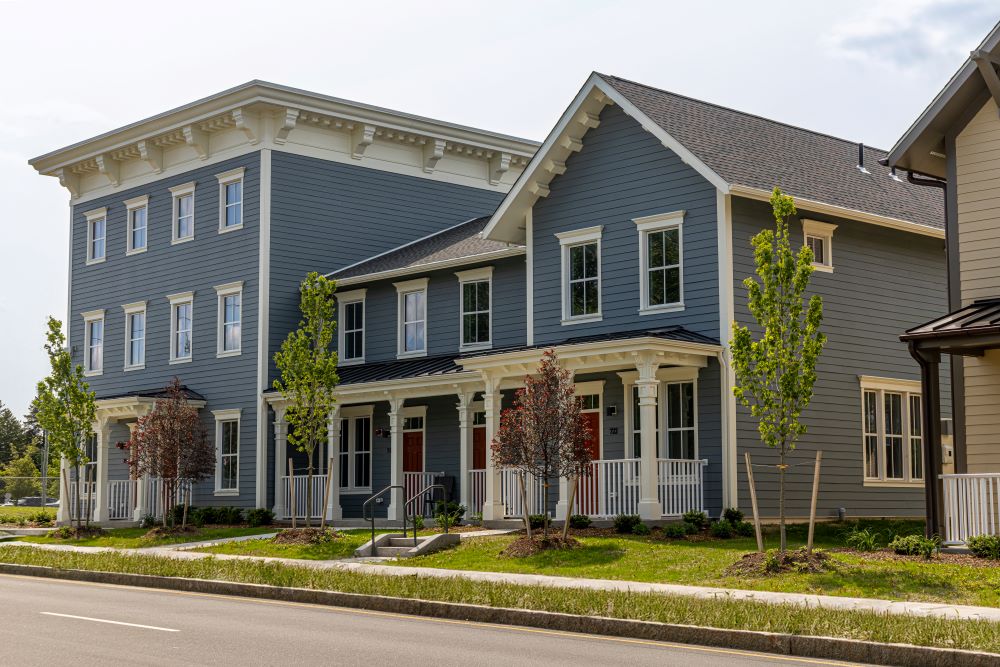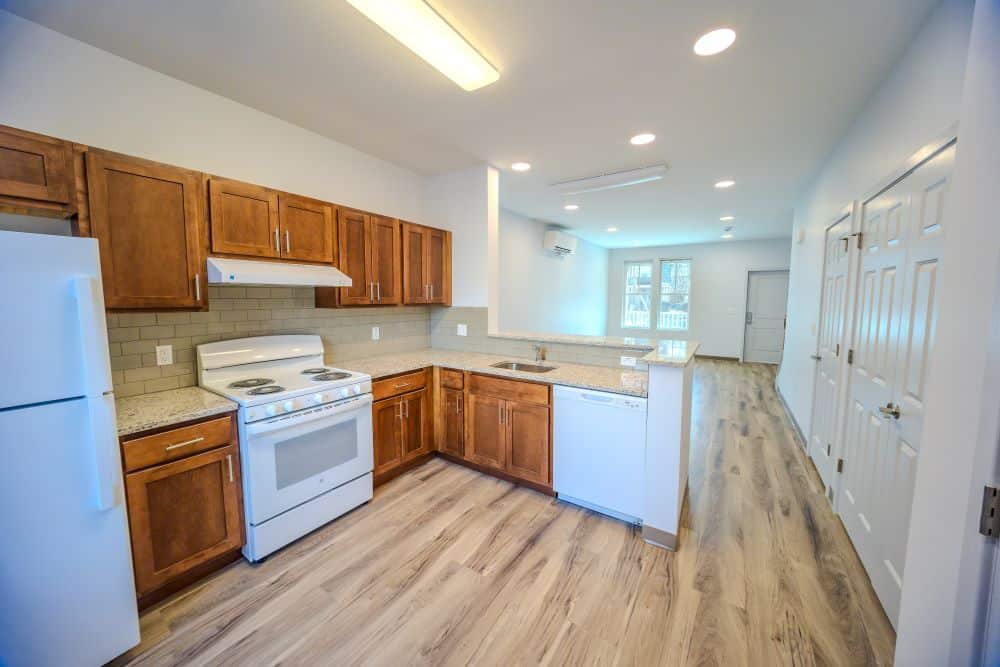Cofield Estates Reclaims Land Once Lost to Highway Construction

By Mark Fogarty
6 min read
In New Haven, a new development is helping to revitalize a former neighborhood once lost to mid-century highway building efforts. Curtis Cofield II Estates brings 56 units of housing to an area that has been vacant for decades.
“In the 1960s, there were businesses, shops, homes, and apartments in that area,” says Micah Hunter, project manager at the NHP Foundation, a New York City-based nonprofit that co-developed the property alongside local developer West River Self Help Investment Plan (West River SHIP). However, the building boom that took place in the decade following the passage of the Federal-Aid Highway Act of 1956 threatened what was then called the Oak Street neighborhood.
“The State of Connecticut used eminent domain and acquired 26 acres of land, including this plot, to expand Route 34,” Hunter explains. “They did some expansion, but in 2004, they agreed not to go any further, and essentially all these neighborhoods were demolished. They’ve been vacant for about 40 years.”
Now, the construction of Curtis Cofield II Estates, completed in May 2025, seeks to repopulate those vacant neighborhoods.
The development is named after the late Rev. Dr. Curtis Cofield II, a longtime civic and religious leader in New Haven. According to the New Haven Independent, Cofield was considered the “dean” of Connecticut’s Black Baptists and was, alongside his wife, Elsie Cofield, a longtime champion of community members living with AIDS. Cofield was also an early advocate for housing to be built on the newly completed project’s long-vacant swatch of land.

Forty-four of Cofield Estates’ units are affordable for households earning up to 60 percent area median income (AMI); this also includes units for households earning 50 and 30 percent AMI. Of those, 12 are set aside for supportive housing, which will be supported by Columbus House, a local nonprofit serving New Haven’s homeless population. The remaining 12 units are workforce housing, reserved for households earning up to 100 percent AMI.
The garden-style complex comprises 11 two- and three-story buildings, offering four one-bedroom apartments, 38 two-bedroom apartments, and 14 three-bedroom apartments. There is also a small retail component and space set aside for a bakery/coffee shop (which the project is still looking to fill).
Today, Hunter says, the project is 90 percent leased up.
Complex Capital Stack Pushes Project to Completion
The relatively complex capital stack featured $12.3 million in nine percent Low Income Housing Tax Credit equity, syndicated by Royal Bank of Canada.
Additionally, the total development cost of $30 million included $6 million in Connecticut Housing Finance Authority (CHFA) taxable bonds, $2 million of combined American Rescue Plan Act (ARPA) and HOME Investment Partnerships Program (HOME) dollars administered by the City of New Haven, and $2 million from the Connecticut Department of Housing (DOH)’s FLEX program. A total of more than a dozen funding sources were ultimately accessed.
This blended financial structure “took a lot of coordination from the public agencies,” says NHP Senior Vice President Scott Barkan. NHP had to figure out how to fill gaps amid escalating costs and interest rates and succeed, Barkan says, because “the public agencies were committed to making this happen.”
A Vital Partnership
Barkan praises West River SHIP’s commitment to the mission in helping turn the project into a reality.
“Our goal at NHP is to help communities implement their visions,” Barkan says. “This community group, [West River SHIP], had a vision of a mixed-income neighborhood, but they didn’t necessarily have the capacity to put together designs and the engineering and the financial structure of it. So, we were grateful to be selected to become their partner. It was really the community’s vision to have this be a mixed-income neighborhood.”
West River SHIP is “a unique group of individuals,” says Hunter. “They were incorporated in 2001, and they were formed as a Self-Help center,” says Hunter, referring to a social movement sparked by Leon H. Sullivan, who helped organize communities of color to pool resources to develop the neighborhoods in which they lived.
“He trained these Self-Help groups nationally, and this (West River SHIP) was the Connecticut chapter,” says Hunter. “They came together to successfully petition for land in the city, and the city decided to earmark this land for them. They were very involved in the development process.”
Efficient and Tenant-Focused Design Principles
Cofield Estates has been built to Passive House standards, says Hunter – “the highest energy efficiency standards for building design. We are projected to achieve 50 to 90 percent energy savings. There’s also solar in one of the buildings that contributes to energy generation.”
Barkan says the firm is excited about the passive house standards. “It’s an interesting test case. Passive House design promotes super energy efficiency. It’s like creating a little cocoon inside a building where the air exchanges are controlled. Rather than just bringing fresh air in from outside, which we do, we also condition that and control the air exchanges, all to create more energy efficiency and a healthier living environment.”
It was a bit of a challenge to do Passive House for affordable townhomes, Barkan says, “but we’re thrilled to do that.”
One way Cofield Estates achieved this passivity is by building completely electric units, with elements such as heat pumps and electric stoves. “It’s not just energy efficient, but sustainable as well,” Hunter says.
Though green funding has retreated significantly during the Trump administration, Barkan says that federal changes “did not impact our financing.”
The tenants “appreciate the way that the project’s built,” says Hunter. The 11 buildings are arranged in a “U shape,” which surrounds a central concentration of parking and community amenities. “With the U shape, almost all the parking is inside that,” he says. “There’s a total of 62 parking spaces, of which four spaces are electric vehicle charging capable. You also have a playground in the U, and parents appreciate being able to look out their window and see their children playing. A lot of them love the aesthetics. These are beautiful buildings.”
NHP aims to keep up the momentum after the success of Cofield Estates. “We are looking to secure some future sites,” says Hunter. “We’ve talked to the city about some prospective developments in New Haven, but we don’t have any definite plans in place.”
Barkan agrees. “We would love to replicate this,” he says.
Breaking Down Cofield Estates’
13 Permanent Funding Sources
- Connecticut State Housing Tax Credits $500,000
- DOH—FLEX $3,320,000
- DOH—HTF $1,980,000
- CHFA Capital Magnet Funds $780,091
- CHFA Opportunity Funds $665,000
- CHFA Additional Loan $719,909
- City of New Haven HOME & ARPA Funds $1,995,000
- FHLB Boston AHP $650,000
- RBC Nine Percent LIHTC Equity $12,274,112
- NHP Sponsor Loan $617,475
- Deferred Fee $465,463
- CHFA Taxable Bonds $6,051,800
- Energy Rebate $357,858
Source: NHP Foundation
